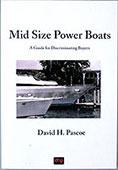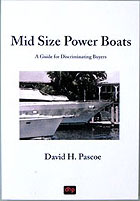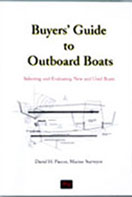Sea Ray 370 AC
by David Pascoe
Aft cabin cruiser, tri-cabin, double cabin flying bridge (DCFB), these are but a few of the names applied to a small boat with three "cabins." But they're only three cabins if you don't count the galley, which actually make for four major interior areas.
Regardless of what you call it, this style boat has always been popular, going all the way back to the 1920's. And it is one of the most difficult layouts to achieve successfully in a small boat because the impetus is to put too much into a too small space. It's one thing in a 42 or 45 footer, but something else again in a boat 37 or 38 feet long.
The Sea Ray 370 AC does it fairly well for a 37 footer. Especially for one that has such a large bow overhang as this one does. And it does it well if you don't mind a salon that is . . . . well, cramped. Here you get two double staterooms, and a decent sized galley -- more about that in a moment -- and two heads, one with a more than adequate stall shower.
This boat has a bolt-on platform, in addition to a molded in platform, thus you loose two feet of interior space for the convenience of being able to step down to it easily (there are molded in steps). I'm not sure this is a good trade-off unless you're going to be spending more time in the water than in the boat. And additional two feet would have made a tremendous difference were it added to the salon.
My own preference has always been for the "great cabin" layout, one that stints on staterooms in favor a single larger social area where people can congregate when the rain is falling, or, as in the southland, out of the heat and sun and into an air conditioned space. While you can do that in the 370, it's going to be more like packing a phone booth or a Volkswagen. It's a nice little salon, but for more than two people, you are likely to be stepping on toes and bumping into each other a lot. There is a convertible sofa (love seat size) and a single swivel chair,
On the other hand, you can stuff the kids or the inlaws at one end, and be isolated at the other, for an overnighter. The lack of floor space will become a bit maddening after a while; the advantage this one offers is separation of quarters. If that's what you want, you get it good here. All kinds of things could be going on in one stateroom without hearing it in the other. Why, you could probably even stash Monica away up there there without the Mrs. knowing about it. But never mind, Monica's going to be busy for a while with other duties.
Better than average engine room access. You'll need to ditch those puny car batteries, though.
With a galley like this, you might want to hire a saucier! Sounds like something from a magazine review, right? But this really is a nice galley. Well done and practical.
This boat has one of the largest galley's you'll ever find in this style boat. Not only large, with room to bend over or turn around, but sufficient counter space and adequate storage. There is a large single basin sink and a three burner stove top. It's the undercounter reefer that provides the extra space that we don't normally see in this kind of layout. It's that extra three feet of space not taken up by an upright reefer that makes it. Naturally, the reefer is smaller, but that is a small price to pay for all the extra elbow room. Besides, the space of larger reefers rarely get used anyway.
The counter top is molded with an integral back board, splash board or whatever it's called, along with a high edge rail. This has the advantage of no ugly caulked seams to mildew or open up, no mica to loosen. No water to trickle down into the cabinets below. Plus it is very easy to keep clean. This is a galley in which one could actually prepare a meal without feeling like working in a phone booth.
Opposite the galley there is no dinette, but a head and a pantry. Well, I don't know what else to call it except maybe the laundry room, for there was a washer dryer combo there, in what amounts to a walk-in closet and a great storage space. The heads have full fiberglass liners and are adequately sized. But there is very little floor space in the forward cabin. You open the door and almost immediately have to climb onto the double bed. Since Monica lives at the Watergate (irony of ironies) she probably wouldn't like that so much.
The interior is largely vinyl and formica. There are padded vinyl panels everywhere. In fact, the thing smells like a vinyl factory there's so much of it, but that also makes it very hushed inside. There is a notable difference in engine noise, compared with other boats, because of it. Okay, well, at least vinyl is easy to clean, but there's always the problem of scuffs, tears and poking holes in it, a condition which was already showing up. Moving things around, you gotta be more careful, or things are going to start looking ratty in a hurry. Ever try to fix a hole in padded vinyl?
The mica is that glossy, rosy woodgrain type used on a very large number of cabinet doors. Meaning that there are a lot of cabinets. All have plastic push-lock latches which were starting to break, as were the imitation Grasso European style hinges. While I didn't count them up, there are a lot of them. You won't have a storage problem here, rather one of figuring out where your stuff is stowed away and which door to look behind. Some folks don't like mica, but I think it's very practical. The stuff lasts forever, yet it's mismatched in terms of durability with all that padded vinyl. The style is modernist without being too tacky, but it surely will not please anyone with a traditionalist bent.
Mechanical Stuff What little floor space there is in the salon is taken up with a huge engine room hatch that gives good access to one side of the engine room, while you have to move the (heavy) sofa to lift another hatch to get at the other side. All-in-all, the engine room access is not bad, except for not being able to reach the spark plugs on the outboard banks of the Mercruiser 502EFI engines which are but 2" away from twin 157 gallon fuel tanks.
Per usual, Sea Ray makes you stand on a little platform about 3" above the bilge, over which oily bilge water sloshes, making it hard to stand up on an oily deck, plus you get to track oil all over your nice salon carpet, which had already happened. White carpet in a boat is always a great idea, so long as you don't mind replacing it annually. At the forward end is a Westerbeke 7kw jenny, which is easily reached. The engines are hard up against the aft bulkhead, so that getting at the outboard corners is near impossible. We found the starboard side fiberglass exhaust pipe (crossover) was so porous that sea water was leaking right through the pipe, and dribbling sea water all over the rear of the engine, making a real mess of things. But the owner wasn't aware of this because it takes a contortionist to even see anything back there. Replacing this is going to be quite a task.
The basic systems installations look generally good, with bronze strainers and sea cocks, real reinforced butyl rubber sea hoses (in most places) but the usual plastic junk above the water line. Sea Ray still doesn't care that plastic thru-hull fittings are still sinking their boats when they break off. The electric panels are placed in convenient locations, but you get a pair of el cheapo car batteries for DC power.
Performance. This boat has deep propeller pockets to achieve a level and more forward engine installation, plus more headroom. While there were specification stickers on both engines, these little labels were completely blank so we don't know what the advertised horse power is. While it is certainly adequate, I wasn't pleased with the performance hit caused by the prop pockets. She's much too slow to get up on plane, pointing her nose high in the air, while having to advance the throttles nearly to full to get her there in a reasonable period of time. There are huge 30' trim tabs to help overcome this **. This is the price to pay for being able to get all this stuff in such a small space. She labors on getting going, and the cruise RPM is notably higher than boats without pockets.
| ** Boats with oversize trim tabs always serve as a clue that trim and performance probably aren't what they should be. |
For this much power and weight, listed at 23,800 lbs, the shafts are decidedly too small at 1-1/4", explaining why we hear so many reports of shaft breakage over the entire SeaRay line.
It's now winter time and no more glassy ocean. Seas were a bit too much to get a good full speed run, yet it was pretty clear that speed wise, this is a rather slow boat that may be marginally powered. At this weight, it needs diesels, and while Cat 3208's are an option, putting these engines in that small space requires a shoe horn. Don't expect a long service life from these engines because this boat is way over the weight line, which we draw at 17,000 lbs. for gas engines. These engines were laboring to push this boat at 20 knots.
If you're looking for performance and speed, don't expect to find it here; there's too much weight on too short a water line. You have to give that up for all these amenities in a small boat. This boat is 7,000 lbs heavier than the Trojan 12 meter, which is slow boat with about the same horsepower (We assume it's 340-350).
While she has a moderate vee hull, she also has that typical spoon-bill Sea Ray bow, which does not make for a good sea boat. Nosing into a 3 foot wave, the bow, rather than the bottom, pounds. Here's a case where mere styling creates a serious performance hit, as well as cutting off a lot of interior space forward. Heading out the inlet against a strong tide rip, we buried the bow under blue water several times. Strictly a fair weather boat. Now we understand why some SeaRays are having hull/deck separation problems. The waves hitting up against an unsupported hull side breaks the screwed together deck join apart.
Design Considerations For a "back porch" boat, stylistically it's pretty good looking. Moving from the aft deck to bridge is very easy with only three steps up. The bridge area is spacious, equipped with soft enclosures hung from a fiberglass arch and stainless framework. Two small pedestal chairs refrain from taking up too much space, offering the rather unique ability to actually be able to walk around each. It's really tiresome climbing over seats getting from one place to the next. As one who hates cramped bridges, this is nice. But the painted aluminum windshield is absurdly weak and floppy, so that anyone who inadvertently grabs onto it for support is likely to damage it.
Ergonomically, the seat/wheel positioning is good, but they totally blew it with the height of the helm panel where the engine controls are much too low, causing a standing operator to have to lean down to reach them. The tiny 16" wheel is attached to a bottom of the line hydraulic steering system. The helm area begins at knee height, which looks as dumb as it is. And like Bayliner often does, they provided a private swimming pool for the engine instruments by mounting them in a depressed area that fills up with water.
And then there's that Roman Lounge. Yep, there it is shown in the photo below. They put all that nice upholstery into a fiberglass shell that fills up with water, so that the thing sits there and stews in its own juices. I guess they expect all those zippered enclosures to keep the water out. This was discovered when we noticed that the carpeted deck was all wet around that chaise. Searching for the source of the water, we found it dripping out from the bottom of the chaise. Cool. More interior designers at work here. Swimming instruments. Swimming upholstery. Irrigation system on deck.
The Roman lounge. It would be fine except that it's sitting in a tray full of water.
Hull. We can see almost nothing of the internal hull except where an interior panel had been removed to reveal the deck join. Here we found the upper hull side and the edge of the deck to be extraordinarily thin. Bang on it with your fist and the structure shudders. The sides at the deck join are washboarded, reflecting where the fasteners are deforming the fairness. It's so weak that any bumping against a dock is going to cause damage. The soft plastic rub rail helps, but not enough. No blisters on the bottom.
The decks are generally solid, as are the housetops. We didn't find any indication of interior leaks. On the other hand, with all that padded vinyl on the sides, if there are any leaks it will be running down behind all this upholstery and won't show up for quite a while, after all that foam rubber becomes saturated. We've got 20 years experience of Hatteras doing this in their forward cabins, and it's not a good thing. Serious leaks don't show up until the water damage is severe.
Caulking. Caulking on the exterior of this boat is everywhere, in every joint where every fiberglass component is joined together. It is sloppy, collects dirt and becomes discolored over time to lend a shabby appearance to some of the other materials they shouldn't have used. This is silly because this caulking isn't necessary. Apparently it was too much trouble to caulk the parts before they were put together, so that the caulking would be within the joint, and not showing on the exterior, but there you have it. It's ugly and marrs otherwise nicely molded parts. There is also a large amount of that plastic called Starboard, which has the properties of Teflon. The caulking does not stick to it, so that it's opened up and loose.
White flubber moldings belong in old Fred MacMurray movies, not on a boat. This is what happens to it.
White Rubber Moldings. These were used on the cut edges of the aft deck coamings (or weather boards), as well as the guard rails. This stuff scuffs and becomes permanently soiled, further blemishing the appearance. White rubber or soft plastic should never be used on a boat because once it discolors -- which it does very rapidly -- it stays that way forever. The bad news is that scores of builders are using this crap in the interest of following blind trends. Only 1-1/2 years old and this quarter million dollar boat is already starting to look shabby because of a few cheap parts.
| Note to Builders: If you want to build a reputation for quality, put the garbage on the inside, not the outside where everyone walking down the dock can see all that cheap junk going to hell. You might as well be hanging up a sign that says: Look at how fast our boats deteriorate!! There's no better way to advertise a lack of quality than producing boats that look clapped out after a few short years. If you don't like to see reviews like this that rip your products to shreds, then use your heads. What people think of your products today depends on how they look tomorrow. |
Skiddish Non-skid. As one who spends his life climbing around on boats, I'm more than cautious when moving around on the decks. But this one got me. Rounded on the corners and sloping forward rather steeply, like walking on ice, my feet went right out from under me even while being aware of how terribly slippery these decks are. I've never seen decks this bad; I could slide 3 or 4 feet easily. The non-skid on this deck is worse than smooth fiberglass. If that weren't bad enough, the bow railing extends beyond the bow by around two feet, so that as I slid toward the railing, expecting that to stop my skid, there was that yawning two foot space between the end of the deck and the rail. Grabbing the rail to keep from going overboard, it bent downward a good six inches because it's just hanging out over empty space with no support.
Plastic Parts. Is there such a cost problem with metal hardware that it now has to be replaced with plastic? Apparently so, for plastic is showing up ever more frequently such as the winch controls, fuel and water fill deck plates, ventilators, hinges and other parts, many of which are already broken on this boat. I can't think of anything that cheapens a boat more than one with broken, crumbling plastic parts.
Summary For the size of the thing, this is decidedly a price boat that offers some reasonably good quality with engineering that is above and beyond what you'd get with most of the competition. I won't name names, but you could do a lot worse with most of the competition. Basically, you're getting what you pay for with some exceptions.
Back porch boats tend to be very clunky looking. People tend to underestimate what an important role good style plays on resale values. Trendy style hurts, while pleasing, more traditional and conservative style helps keep prices up. People jump on trends, but pleasing lines are what sells on the resale market long after the latest fashion sours. On this one, the "bubble boat" styling has mercifully been minimized, and for a floating veranda, this is one of the few I've seen that almost looks good. These huge structures tacked onto the back of any boat disrupts the flow of lines, but somehow this one seems less clunky.
Except for that ice slick of a foredeck, there are few major design stupidities. There's a lot crammed into a small space and it's done about as well as it can be done.
 Visit davidpascoe.com for his power boat books
Visit davidpascoe.com for his power boat books 














David Pascoe is a second generation marine surveyor in his family who began his surveying career at age 16 as an apprentice in 1965 as the era of wooden boats was drawing to a close.
Certified by the National Association of Marine Surveyors in 1972, he has conducted over 5,000 pre purchase surveys in addition to having conducted hundreds of boating accident investigations, including fires, sinkings, hull failures and machinery failure analysis.
Over forty years of knowledge and experience are brought to bear in following books. David Pascoe is the author of:
In addition to readers in the United States, boaters and boat industry professionals worldwide from nearly 80 countries have purchased David Pascoe's books, since introduction of his first book in 2001.
In 2012, David Pascoe has retired from marine surveying business at age 65.
On November 23rd, 2018, David Pascoe has passed away at age 71.
Biography - Long version